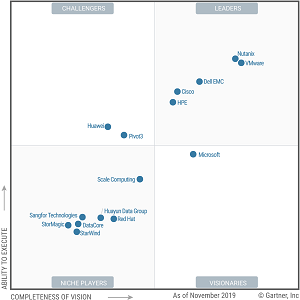News
Report: Growing HCI Space Boosted by Cloud, AI
The hyperconverged infrastructure (HCI) space is growing fast as it adjusts to new technologies and factors such as artificial intelligence and hybrid/multicloud implementations, according to a new report from research firm Gartner Inc.
The company's new "Magic Quadrant for Hyperconverged Infrastructure" report finds Nutanix and VMware at the top of a pack of "Leaders" that also includes Dell EMC, Cisco and HPE. Gartner describes HCI as "a category of scale-out software-integrated infrastructure that applies a modular approach to compute, network and storage on standard hardware, leveraging distributed, horizontal building blocks under unified management." It basically substitutes old-world, proprietary, hardware-based, purpose-built systems with software-centric, integrated systems running on commercial off-the-shelf servers, with the focus on virtualized networking, compute and storage.
The report says better HCI scalability and management functionality will result in 70 percent of enterprises running some form of HCI (that is, appliance, software, cloud-tethered) by 2023, up from less than 30 percent this year.
While the movement is growing, it's also evolving, Gartner said, with some implementations leveraging AI to automatically improve performance and prevent failures, and others increasingly supporting different kinds of cloud implementations.
The cloud, the report indicates, can almost be thought of as a double-edged sword.
"For most HCI vendors, the public cloud is an extension of the strategy, but also could be a strategic threat if IT leaders buy public cloud services in lieu of spending on their own infrastructure," the report says. Furthermore, different kinds of cloud applications are being considered. "At the same time, HCI vendors have expanded their strategy to embrace hybrid/multicloud deployments, as either backup targets or disaster recovery options, or as an alternative for on-premises infrastructure for unpredictable or cyclical resource requirements."
Overall, Gartner said of the market, "Hyperconverged infrastructure solutions are making substantial inroads into a broader set of use cases and deployment options, but limitations exist. Infrastructure and operations (I&O) leaders should view HCI solutions as tools in the toolbox, rather than as panaceas for all IT infrastructure problems."
 [Click on image for larger view.] Magic Quadrant for HCI (source: Gartner).
[Click on image for larger view.] Magic Quadrant for HCI (source: Gartner).
As noted, many of those tools come from vendors in the "Leaders" quadrant: Nutanix, VMware, Dell EMC, Cisco and HPE. Microsoft was the only vendor in the "Visionaries" section, while Huawei and Pivot3 were named "Challengers" and the final camp of "Niche Players" consisted of Scale Computing, Huayun Data Group, Red Hat, Sangfor Technologies, StorMagic, DataCore and StarWind.
To be eligible for the study, HCI vendors' functional criteria included:
- Provide an integrated software stack, which includes unified management, software-defined compute (SDC), storage and, optionally, networking.
- Combine VM and SDS resources, both running on the same physical servers, as the primary deployment method.
- Virtualize local, internal and direct-attached storage (DAS), rather than shared, networked storage, such as a SAN and/or network-attached storage (NAS).
- Provide a mechanism to pool internal and direct-attached primary storage across servers into logical, abstracted virtual storage.
- Develop the storage and data management services integrated in the offering.
Gartner also revisited the cloud factor in providing context for the report.
"One of the attractions of integrated systems and HCI is the potential to create a cloudlike provisioning model while maintaining physical control of IT assets and data on-premises in the data center, remote site or branch office," the report said. "Over the next few years, cloud deployment models will become increasingly important to meet both short-term scale-up/scale-down requirements and backup and disaster-recovery requirements. An important question for users is whether HCI is a stepping stone to the cloud or a 'foreseeable future' resting place for applications; and ultimately, whether it is a good alternative to the public cloud from performance, manageability at scale and cost perspectives."
A copy of the report licensed for distribution is available from VMware here.
About the Author
David Ramel is an editor and writer at Converge 360.